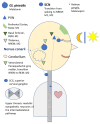Postnatal Development of the Circadian Rhythmicity of Human Pineal Melatonin Synthesis and Secretion (Systematic Review)
- PMID: 39457162
- PMCID: PMC11506472
- DOI: 10.3390/children11101197
Postnatal Development of the Circadian Rhythmicity of Human Pineal Melatonin Synthesis and Secretion (Systematic Review)
Abstract
Introduction: According to current knowledge, at birth, the pineal gland and melatonin receptors are already present and the suprachiasmatic nucleus is largely functional, and noradrenaline, the key pineal transmitter, can be detected in the early foetal period. It is still unclear why the pineal gland is not able to start its own pulsatile synthesis and secretion of melatonin in the first months of life, and as a result, infants during this time are dependent on an external supply of melatonin. Method: The causes and consequences of this physiological melatonin deficiency in human infancy are examined in a systematic review of the literature, in which 40 of 115 initially selected publications were evaluated in detail. The references of these studies were checked for relevant studies on this topic. References from previous reviews by the author were taken into account. Results: The development and differentiation of the pineal gland, the pinealocytes, as the site of melatonin synthesis, and the development and synaptic coupling of the associated predominantly noradrenergic neural pathways and vessels and the associated Lhx4 homebox only occurs during the first year of life. Discussion: The resulting physiological melatonin deficiency is associated with sleep disorders, infant colic, and increased crying in babies. Intervention studies indicate that this deficiency should be compensated for through breastfeeding, the administration of nonpooled donor milk, or through industrially produced chrononutrition made from nonpooled cow's milk with melatonin-poor day milk and melatonin-rich night milk.
Keywords: Lhx4-Homebox; chrononutrition; circadian rhythm; melatonin in infants; noradrenaline; pineal gland; pinealocytes.
Conflict of interest statement
The author declares that there are no conflicts of interest. He is a voting member of the Ethics Commission of the Technical University of Dresden, managing partner of kleanthes Verlag für Medizin und Prävention GmbH & Co. KG, Dresden, and author of the patent application cited in this article [73].
Figures





References
Publication types
LinkOut - more resources
Full Text Sources

